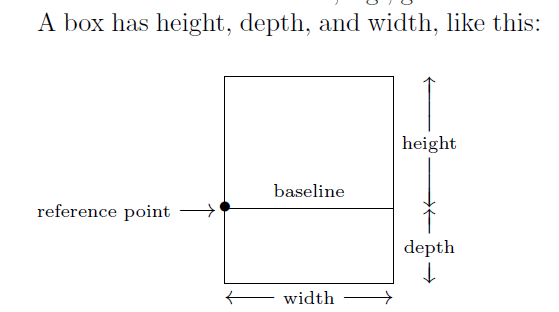基本概念
tex的解剖学结构 anatomy of TEX
eye:从输入文件将字符读到mouth中
mouth:将字符character变成token
gullet食道:将macros, conditionals, and similar construct进行展开,注意,展开一个token之后可能导致其他token也需要展开,一般情况下是从左到右展开,除非遇到了改变展开顺序的command 如\expandafter,然后将其送到stomach胃里边。
stomach:将token按照group进行处理,其实就是将字符等组装成page,然后送到肠道。如line breaking(将段落break成行),page breaking(将行和其他vertical mode material转化成page)
intestines(肠道):将page转化为其他形式,将输出发送到.dvi文件。
box
来源:p51
box就是要排版的一个矩形
小到一个字符,大到一个page都是一个个box,。
整个page就是一个个互相嵌套的box
Tex在构建paragraphs and pages的时候会隐式地进行box-building。
当然我们也可以用命令来显示地创建。
如\hbox在box列表里边从左到右加box,\vbox和\vtop从上到下加。
每一个box都有几个指标:

注意,字符g的一部分在baseline下面,字符h全在上面。
另外
Roughly speaking, then,
\vboxputs the reference point near the bottom
of the vbox and\vtopputs it near the top
将box放到一个box寄存器就行了,使用box寄存器之前当然要用\newbox来reserve并命名一个box。
font相关
来源:p64 p221
一个font就是有同样typeface design的256个字符的集合
原则是定义、加载、然后使用
例如,\font\twelvebf=cmbx12,这里\twelvebf是我们用来name字体的,cmbx12就是我们电脑里边存着的font metric文件的名字。
注意我们要用grouping来限制这个\twelvebf的作用域。
例如:
{\twelvebf white rabbits like carrots}
另外,字体文件一般有俩,一个指定字体的metric(.tfm),另一个指定该字体的shape(.pk或.gf),Tex只关心metric,具体这个字咋写的人家并不关心,
谁用呢?
device driver负责将.dvi转化为设备能识别的东西,也就是device driver才会关心这个shape文件。
\font的具体用法:
\font
\font hcontrol sequencei = hfontnamei
\font hcontrol sequencei = hfontnamei scaled hnumberi
\font hcontrol sequencei = hfontnamei at hdimeni
\font单独用的时候并不是一个command,用来取出font的值,这样就可以作为参数传给其他命令了。
后面三种就是上面例子所指出的了。
需要指出的是,字体文件名一般自带默认的design size,如cmr10就是10 points大小的。
最后俩用来在design size的基础上进行放缩的:
scaled <number> 的时候 <number>/1000
at <dimen> 的时候 <dimen>/ds, where ds is the design size of <fontname>
书上 p23 有个例子:
% The next two lines define fonts for the title
\font\xmplbx = cmbx10 scaled \magstephalf
\font\xmplbxti = cmbxti10 scaled \magstephalf
% Now here's the title.
\leftline{\xmplbx Example 1:\quad\xmplbxti Entering simple text}
这个例子中出现了\magstephalf,这就牵涉到magnification了
magnification
tex排版的时候,所有的dimension都会乘以一个因子 f/1000,其中f是\mag参数的值。\mag的默认值是1000,tex定义了几个常用的放大倍数对应的值,如1.2倍的\magstep1,1.4倍的\magstep2。介于前俩之间的\sqrt{1.2}倍的\magstephalf,总共定义到\magstep5
除了这种相对放大,还有一种直接指定的,即加上true如 \kern 8 true pt,不管放大倍数多少,我都产生8 points的kern
kern
来源:p157
horizontal mode的时候,一个正的kern会将tex右移,负值左移
vertical mode的时候,正值下移,负值上移
kern和glue很像,只是kern不能stretch和shrink,并且一般kern的地方不能break a line or a page,除非kern后边跟了个glue
注意两点
- kern在行末或page末尾的时候是没效果的,这时候可以用
\hglue or \vglue - 另外,kern在math mode的时候不能使用mu(mathematical unit),要想用的话,请使用
\mkern
thinspace
来源:p153
\thinspace 产生一个 $1/6$ em 的kern,也就是将tex往右移动一点点。
主要用于nested quotation的时候,例如:
``\thinspace`A quote.'\thinspace''\par
24,\thinspace 29--31,\thinspace 45,\thinspace 102
vglue 和 hglue
来源:p156
这个 \vglue 就是一种variable-size space了。
用法:\vglue <glue>
其中\vglue用于产生一个即使page break也不会消失的glue
\hglue产生一个即使line break也不会消失的glue
除此之外,这俩命令就和\hskip and \vskip一样了。
\vglue 可以用于在page顶端的一个空行(即title上面),但这么用的话,明显 \topglue更适合一点。
hskip 和 vskip
来源:p155
\hskip <dimen1> plus <dimen2> minus <dimen3> i
\vskip <dimen1> plus <dimen2> minus <dimen3> i
分别用于产生horizontal and vertical glue。
`
register
来源:p89
register类似编程中的variable的概念。
总共有五种register:
Register type Contents
box a box
count a number
dimen a dimension
muskip muglue
skip glue
toks a token list
每一中寄存器都有256个值,从0到255进行寻址。
具体的寻址方式是‘寄存器名+index’,例如\muskip192,\count12
怎么对寄存器赋值呢?
书中给出了两种方式的例子,box单独列出来有可能是因为它有点复杂
\setbox3 = \hbox{lagomorphs are not mesomorphs}
\count255 = -1
定义好之后,这样就可以用 \box3了,同理,count register 255现在的值是-1.
上面说到box比较特殊,是因为,box读出来之后,该box就会被清空。
一个解决方案就是用\copy来提取box 寄存器的值,同时不清空该寄存器。
很多寄存器都是留个tex自己用的,咱们不能用。如\count0到\count9用于存储page numbering的相关信息。\box255用于存放当前页的的内容。
tex运行的时候,可以使用 \showthe查看寄存器的值,如\showthe\dimen0
使用register
\count <register> = <number>
\dimen <register>= <dimen>
\skip <register>= <glue>
\toks <register>= <token variable> 或 {<token list>}
当然,以上的=可以省掉。
对于\count这种寄存器r来说,只有\count255不需要我们去定义就能用。
对于\dimen来说,\dimen0-\dimen9,以及\dimen255也是可以直接用
对于\skip来说,\skip0-\skip9,以及\skip255也是可以直接用
对于\toks,可以赋给它一个token变量(一个寄存器或参数),或者token 变量的list,此时这个list并不会直接展开,而是需要使用 \the.
如:
\toks0 = {the \oystereaters\ were at the seashore}
% This assignment doesn't expand \oystereaters.
\def\oystereaters{Walrus and Carpenter}
\toks1 = \toks0
% the same tokens are now in \toks0 and \toks1
Alice inquired as to whether \the\toks1.
结果就是:Alice inquired as to whether the Walrus and Carpenter were at theseashore.
好了,上面的 <register>,如何定义呢?我们需要new一下啦。
Naming and reserving registers,
\newcount
\newdimen
\newskip
\newmuskip
\newtoks
\newbox
\newread
\newwrite
\newfam
\newinsert
\newlanguage
这么多哈哈。
其中正常的几个new,如 \newcount, \newdimen, \newskip, \newmuskip, \newtoks, and \newbox定义出来(或者叫reserve)的都是正常的register,
而\newbox, \newread, \newwrite,\newfam, \newinsert, and \newlanguage定义出来的都是对应的register的index。
如\newbox\figbox这么搞之后,\figbox只能和box相关的command一块儿用,如 \setbox\figbox = \vbox{: : : }
宏 macro
来源:p230 p75
\def <control sequence> <parameter text> { <replacement text> }
macro其实就是一个定义,给这些token一个name
最多可以使用9个参数。
参数有两种类型:
- delimited parameters
- undelimited parameters
即没有分割的参数,和有分割的参数。
没有分隔符的很容易理解。
对于有分隔符的,举个例子:\def\diet#1 #2.{On #1 we eat #2!}
那么调用的时候必须:\diet Tuesday turnips.或者\diet {Sunday mornings} pancakes.注意里边的空格和句号,必须对应。
用一个宏定义另一个宏
来源:p78
这个需求在很多latex的class文件都有。
例如,thuthesis的
\def\thu@def@term#1{
\define@key{thu}{#1}{\csname #1\endcsname{##1}}
\expandafter\gdef\csname #1\endcsname##1{
\expandafter\gdef\csname thu@#1\endcsname{##1}}
\csname #1\endcsname{}}
\thu@def@term{secretlevel}
\thu@def@term{secretyear}
\thu@def@term{ctitle}
\thu@def@term{etitle}
这个需求的详细表述:
define a macro that in turn defines a second macro
我们应该如何才能不让Tex对第二个macro的参数不confused呢?
答案是,在第一个macro展开的时候,写俩#.
例如:
\def\first#1{\def\second##1{#1/##1}}
这样,当我们调用\first{One}的时候,就会将\second定义成:\def\second#1{One/#1}
csname
\csname <token list> \endcsname
这个用于从<token list>产生一个control sequence。
多说一点,它主要用来合成一些很难直接写的控制序列。
这样我们自定义一些“整齐”的命令名的时候就方便了
注:<token list>本身也可以包含控制序列,如
\def\capTe{Te}
This book purports to be about \csname\capTe X\endcsname
expandafter
\expandafter <token1> <token2>
这个命令,让tex先展开一层<token2>(注意,一次只展开一层), 然后再找机会展开 <token1>.
主要适用情况:<token1>会影响<token2>的展开,例如<token1>是{或者\string
一个例子:
\def\aa{xyz}
\tt % Use this font so `\' prints that way.
[\string\aa] [\expandafter\string\aa]
[\expandafter\string\csname TeX\endcsname]
最后输出:[\aa] [xyz] [\TeX]
我们重点关注一下第三个例子\expandafter\string\csname TeX\endcsname
先展开\csname,后展开\string,而展开\csname时候,必须配对,即找到\endcsname为止,因此变成了\string\TeX
稍微上层一点的
noident
来源:p112
当tex结束一个段落的时候会进入vertical mode,此时noident命令就会执行以下命令:
- 首先插入
\parskip这个段间glue, - 将tex设为horizontal mode
- 开始一个unindented paragraph
当然,noident还有另一个功能:
取消段落首行的indent
如下面例子
\parindent = 1em
Tied round the neck of the bottle was a label with the
words \smallskip \centerline{EAT ME}\smallskip
\noindent beautifully printed on it in large letters
par
\par 用来结束一个段落
将tex设为vertical mode
注意:由于tex会将空行识别成\par这个token,因此这个命令不常用。
由于\par也会产生interparagraph space,因此可以使用\vskip -\lastskip来把它取消掉。
另外,\par不同于\noident,\par并不会让tex重新开始一个新的段落。
其他终止段落用的命令
\smallskip:用来skip 3个point,and can stretch or shrink by 1 point
\vskip
\medskip 等价于俩\smallskip
\bigskip 等价于俩\medskips
llap
\llap <argument>:将当前位置往左移动<argument>的宽度,输出<argument>
一般用于将文本放到outside of the current margins
hbox
\hbox { <horizontal mode material> }
\hbox to <dimen> { <horizontal mode material> }
\hbox spread <dimen> { <horizontal mode material> }
总共有以上三种用法。
第一种,hbox具有{
对于后两种情况,一般需要手动加入\hfil
如:
\hbox{ugly suburban sprawl}
\hbox to 2in{ugly \hfil suburban \hfil sprawl}
\hbox spread 1in {ugly \hfil suburban \hfil sprawl}
% Without \hfil in the two preceding lines,
% you'd get `underfull hbox'es.
另外:
\line <argument>会产生一个等于当前行长度的hbox,并将argument放进去。
leaders
\leaders <box or rule> <skip command>:重复
\def\dotting{\leaders\hbox to 1em{\hfil.\hfil}\hfil}
\line{The Political Process\dotting 18}
\line{Bail Bonds\dotting 26}
会产生类似目录的效果,即项目…页码。
其中\hbox to 1em{\hfil.\hfil}是要重复的东西,称为leader,而<skip command>就是后边的\hfil
改变字体
\font\tenrm = pplr % Palatino
% Define a macro for invoking Palatino.
\def\pal{\let\rm = \tenrm \baselineskip=12.5pt \rm}
\pal % Use Palatino from now on.
其中\let <control sequence> = <token>就是让<control sequence>获取<token>的当前meaning。
而此处\rm就是一种和\bf,\it等并列的一种font style。